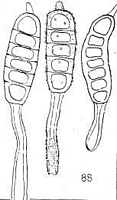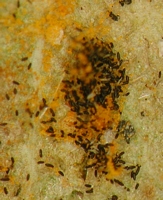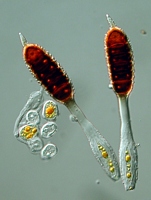|
 Phragmidium mucronatum Phragmidium mucronatum
SynonymsPhragmidium subcorticium
Puccinia mucronata
BiostatusPresent in region - Exotic
Images (click to enlarge)
Caption: FIG. 88. Phragmidium mucronatum Schlecht. Teleutospores from Rosa sp. cult. | 
Caption: Uredinia and telia on leaf
Owner: J.A. Cooper | 
Caption: Telia
Owner: J.A. Cooper |
Article: Cunningham, G.H. (1924). The Uredinales, or rust-fungi, of New Zealand: supplement to Part 1; and Part 2. Transactions and Proceedings of the New Zealand Institute 55: 1-58 Wellington:.
Description: 0. Spermogones caulicolous, sparse, flattened, immersed, honey-coloured.
I. Caeomata hypophyllous, caulicolous, petiolicolous and fructicolous, on leaves scattered
or crowded, orbicular, pulvinate, 0.25-1 mm. diam., on stems confluent, up to 20 mm. long,
forming large inflated distortions; reddish-orange, pulverulent; paraphyses present and as a
rule encircling only the smaller sori; incurved, clavate, hyaline. Spores elliptical, obovate,
or subglobose, 22-30 x 15-23 mmm.; epispore hyaline, finely and densely verruculose, 2-2.5 mmm. thick, cell-contents oily,
reddish-orange.
II. Uredosori hypophyllous, scattered, seated on pallid-yellow spots, orbicular, 0.25-0.5
mm. diam., orange, pulverulent; encircled by a layer of incurved.hyaline, clavate
paraphyses. Spores elliptical, obovate, or subglobose, 22-28 X 15-20 mmm.; epispore
hyaline, closely, finely and bluntly echinulate, 2 mmm. thick, cell-contents pallid-orange;
germ-pores scattered, numerous (6-8), obscure.
III. Teleutosori hypophyllous, scattered, orbicular, 0.25-0.5 mm. diam., somewhat
pulverulent, black, naked, with numerous spores in each sorus. Spores 5-9-celled,
commonly 7-8, oblong-terete, 72-98 X 28-35 mmm.; apex obtusely rounded, not thickened,
crowned with a prominent papilla, hyaline at the tip, coloured below, not continuous with
the upper cell-wall, up to 12 mmm. long, base rounded or truncate, spore narrowed slightly
above and below; not constricted at the septa; wall dark chestnut-brown, opaque, 5-7
mmm. thick, unevenly covered with coarse hyaline warts which are more numerous
apically; pedicel persistent, continuous with the spore, tinted above, hyaline below, hollow,
up to 150 mmm. long, 8-10 mmm. thick, slightly (15 mmm.) swollen at the base, lower
third minutely and closely verruculose, central area filled with an oily orange-coloured
matrix; germ-pores 3-5 in each cell, commonly 3, conspicuous.
Distribution: Distribution: Europe; western Asia; North and South America; Hawaii; Ceylon; Australia.
Notes: Both hosts are introduced, the former being common throughout. The caeomata form
conspicuous reddish-orange inflated areas on the stems of sweetbrier. The mycelium of this
stage is perennial in the host-tissues, so that once the plant has become infected the rust
appears on it season after season. Spores so produced cause local infection of the leaves, and
these sori in turn give rise to uredo- and teleuto-spores.
This rust is prevalent throughout the Nelson and Marlborough districts, and in the spring
becomes conspicuous on account of the brilliant colour of the caeomatospores.
Ramsbottom (1913) has shown that the name of this species should be as above.
Article: Gadgil, P.D. (in association with Dick, M.A.; Hood, I.A.; Pennycook, S.R.) (2005). Fungi on trees and shrubs in New Zealand. Fungi of New Zealand. Ngā Harore o Aotearoa 4: xi + 437 p. Hong Kong: Fungal Diversity Press.
Description: Type: Rust and Smut Fungi; Description: Spermagonia in small groups, flat, pale honey-yellow, 0.1–0.2 mm in diameter; on upper surfaces of leaves and on twigs. Aecia on lower surfaces of leaves scattered or crowded, roughly circular, bright reddish orange, 0.25–1.0 mm in diameter; those on twigs confluent, forming large inflated distortions, bright reddish orange, up to 20 mm long; also on fruits. Aeciospores ellipsoid, 22–30 × 15–23 μm, finely and densely verruculose, pale yellow. Uredinia scattered or in groups, roundish, orange, 0.1–0.3 mm in diameter, in pale yellow spots; on the lower surfaces of leaves. Urediniospores globoid to ellipsoid, 22–28 × 15–20 μm, finely and bluntly echinulate. Telia scattered or in groups, rounded, black, 0.2–0.5 mm in diameter; on the lower surfaces of leaves. Teliospores ellipsoid to subfusoid, 6–7-septate, 72–98 × 28–35 μm, base rounded, apex with an almost hyaline, prominent papilla, chestnut brown, coarsely verrucose; pedicel persistent, longer than the spore.
Distribution: Distribution: Auckland, Wanganui, Wellington, Nelson, Marlborough, Kaikoura, Mid Canterbury, Central Otago, Dunedin.; 1st Record: Kirk (1901).
Article: Dingley, J.M. (1969). Records of plant diseases in New Zealand. New Zealand Department of Scientific and Industrial Research, Bulletin 192: 298 p. Wellington:.
Notes: Rose rust is common throughout New Zealand (Cunningham, 1924a). As it causes premature
defoliation and limits growth of plants, it is of economic importance in nurseries and commercial
plantings. Marcussen (1962) recommended for its control regular sprays with zineb or sulphur.
Cockayne (1910) suggested that it could be used for the biological control of sweet briar in Otago
and south Canterbury, but, as it is difficult to establish the rust, its use in biological control is
limited (Cunningham, 1927a).
|